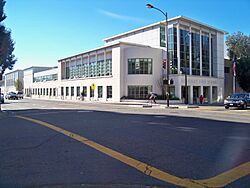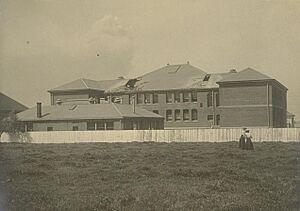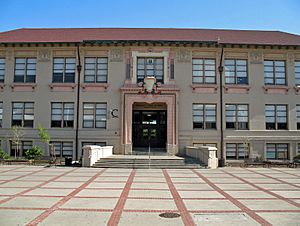Berkeley High School (California) facts for kids
Quick facts for kids Berkeley High School |
|
|---|---|
 |
|
 |
|
| Address | |
|
1980 Allston Way
, 94704
United States
|
|
| Coordinates | 37°52′04″N 122°16′17″W / 37.86772°N 122.27141°W |
| Information | |
| School type | Public high school |
| Established | 1880 |
| School district | Berkeley Unified School District |
| NCES District ID | 0604740 |
| NCES School ID | 060474000432 |
| Principal | Juan Raygoza |
| Teaching staff | 172.39 (FTE) |
| Grades | 9-12 |
| Enrollment | 3,220 (2023–2024) |
| Student to teacher ratio | 18.68 |
| Hours in school day | 7 |
| Campus type | Urban |
| Color(s) | Red and gold |
| Athletics conference | West Alameda County (WAC) |
| Nickname | Yellowjackets |
| Accreditation | Western Association of Schools and Colleges (WASC) |
| Newspaper | Berkeley High Jacket |
| Yearbook | Olla Podrida |
| Feeder schools | King Middle School Willard Middle School Longfellow Middle School |
| Website | Berkeley High School |
Berkeley High School is a public high school in Berkeley, California, United States. It is the only public high school in the city. The school is part of the Berkeley Unified School District. You can find it in Downtown Berkeley, near Shattuck Avenue and University Avenue. The school's mascot is the Yellowjacket.
Some of the buildings on the campus are special. The city of Berkeley recognizes them as a Berkeley Landmark. Also, since 2008, eight of the campus buildings have been listed as a historic district on the National Register of Historic Places. This means they are important historical sites.
Contents
Discovering Berkeley High School's Past

Early Beginnings of the School
The first public high school classes in Berkeley started in 1880. They were held at the Kellogg Primary School. The first students graduated from high school in 1884. In 1895, the school published its first yearbook, called Crimson and Gold. Later, its name changed to Olla Podrida by 1899.
In 1900, people in Berkeley voted to build a special campus just for the high school. Construction began in 1901 on the land where the school is today. The main building was located where the "H" building now stands.
Surviving the 1906 Earthquake
The main school building was damaged during the 1906 San Francisco earthquake. Chimneys fell, windows broke, and some walls became weak. A professor from the University of California, Andrew Lawson, took photos of the damage. These photos were included in his famous report in 1908. The building was fixed and reopened. Later, in 1934, it was taken down. New buildings, the "H" and "G" buildings, were built in its place.
Expanding the Campus and Programs
In 1964, the West Campus of Berkeley High School opened. It was for all ninth-grade students. The main campus served grades 10–12. The West Campus was later used by the Berkeley Adult School. Today, the main building of the former West Campus holds the administrative offices for the Berkeley Unified School District.
Many famous performers have played at the Berkeley Community Theater. This theater is located on the Berkeley High campus. For example, Paul Robeson sang there in 1952. In 1957, Stan Getz performed at the Berkeley Jazz Festival held there.
Student Activism and New Ideas
During the 1960s, many students and teachers at Berkeley High were involved in political activism. They protested against the Vietnam War. They also supported civil rights and new studies about different cultures. The campus had student groups like the Black Students Union and the Chicano Student Union. In 1971, students elected a student who challenged traditional ideas for Homecoming Queen.
Berkeley High School has also been creative with its school programs. In 1970, a "school within a school" called Community High School opened. It offered an "alternative" way of learning. By 1974, there were several small schools inside Berkeley High. These included Genesis-Agora, Model School A, School of the Arts, and College Prep. Berkeley High School was also the first public high school in the United States to have an African American Studies department. This department was started in 1969.
How Berkeley High School is Organized
Understanding Student Diversity
Berkeley High School has a very diverse student body. This means students come from many different backgrounds. As of the 2017–2018 school year, there were 3,118 students. About 40% were White, 23% Hispanic or Latino, 15% African American or Black, and 8% Asian. Many students also identified as two or more races. About 30% of students received free or reduced-price meals, were learning English, or were in foster care.
Addressing the Achievement Gap
The "achievement gap" refers to differences in how well different groups of students perform in school. At Berkeley High, there has been a gap between white students and black and Latino students. This gap shows up in test scores, graduation rates, and how many students take advanced classes or go to college. For example, in 2017–18, 86% of white students met college application requirements. This compared to 40% of black students and 50% of Latino students.
The school has worked to close this gap. They want all students to have the same chances to succeed.
Creating Smaller Learning Communities
In 2000, Berkeley High started trying out the idea of "small schools." The goal was to help all students, especially to close the achievement gap. By 2005, the school officially had four small schools and a larger program called Academic Choice.
The small schools that started in 2005-06 were:
- The Arts and Humanities Academy (AHA)
- Communication Arts and Sciences (CAS)
- Academy of Medicine and Public Service (AMPS)
There are also two larger learning communities. These make up almost two-thirds of the students. They are:
- Academic Choice (AC)
- Berkeley International High School (BIHS), which is part of the International Baccalaureate (IB) program.
Before the 2018 school year, new freshmen chose which learning community they wanted to join. However, this system did not fully close the achievement gap. Some communities had more students from certain backgrounds. For example, AMPS had more African American and Latino students. These communities also had more students who scored lower on state tests.
Student Demographics by Learning Community (2010-2011)
This table shows the different groups of students in each learning community in 2010-2011.
| Small school | Native/Asian/Pacific | Latino | African American | White | Multi | Unknown | Total |
|---|---|---|---|---|---|---|---|
| Academic Choice (AC) | 13% | 12% | 19% | 41% | 11% | 4% | 1336 |
| Arts and Humanities Academy (AHA) | 8% | 14% | 30% | 36% | 10% | 1% | 236 |
| Berkeley International High School (BIHS) | 9% | 11% | 20% | 47% | 11% | 2% | 918 |
| Communications Arts & Sciences (CAS) | 5% | 19% | 34% | 27% | 13% | 1% | 231 |
| Medicine and Public Service (AMPS) | 6% | 24% | 51% | 9% | 7% | 3% | 238 |
| All of BHS | 10% | 13% | 26% | 37% | 11% | 3% | 3241 |
Student Test Scores by Learning Community (2011)
This table shows how many students in each community scored "proficient or above" on state tests in 2011.
| Small school | Enrollment 2011 | English 2011 | Math 2011 |
|---|---|---|---|
| Academic Choice (AC) | 1,300 | 57% | 30% |
| Berkeley International High School (BIHS) | 900 | 69% | 33% |
| Arts and Humanities (AHA) | 240 | 47% | 7% |
| Communication Arts & Sciences (CAS) | 240 | 31% | 6% |
| Medicine & Public Service (AMPS) | 240 | 22% | 2% |
| Berkeley High School average | 3,200 | 52% | 23% |
| California state average | 49% | 28% |
New Approach: Universal 9th Grade
In 2015, the school started planning a big change. They decided to create a "universal 9th grade." This means all freshmen are placed into core groups of about 120 students. These groups are called "hives." Students in a hive share four teachers for their main subjects: Math, Physics, English, and Ethnic Studies/Social Living. They also choose two other classes.
The idea is that students will learn about the different learning communities firsthand. Then, at the end of ninth grade, they choose which community they want to join for grades 10-12. This program started in the fall of 2018. It aims to make sure all students get a fair start and support.
School Departments and Student Activities
Berkeley High School has many different departments and activities for students.
- African American Studies Department
- Athletics: basketball, badminton, football, track and field, and more.
- Computer Technology
- English and World Language
- History
- Journalism, which produces the school newspaper, the Berkeley High Jacket
- Mathematics
- Physical Education
- Science
- Special Education
- Visual and Performing Arts: including a Jazz Ensemble
- Many clubs like Mock Trial, Robotics, and Youth & Government.
Exploring the Campus and Buildings
The Berkeley High School campus is quite large. It covers four city blocks. The first building cornerstone was placed in 1901. Since then, the campus has been almost continuously under construction.
In the late 1930s, many old buildings were replaced with new ones. The Florence Schwimley Little Theater, the Berkeley Community Theatre, and the G and H buildings are examples of the Streamline Moderne style. This style was popular at the time. These buildings were largely paid for by a government program called the WPA. They also feature cool sculptures by artists like Robert Boardman Howard.
Notable People from Berkeley High School
Many interesting people have attended or worked at Berkeley High School. You can find a longer list of them in the article: List of Berkeley High School (Berkeley, California) people.


